Higher Education Market Entry in Fujairah: A Literature Review Project
VerifiedAdded on 2022/01/05
|6
|1371
|109
Literature Review
AI Summary
This literature review examines the higher education landscape in Fujairah, UAE, focusing on market entry opportunities. It explores the historical development of education in the UAE, highlighting the increasing competitiveness of the higher education sector and the rise of international branch campuses. The review analyzes student preferences, including the trend of studying abroad versus local options, and the impact of globalization on education and employment. It discusses the challenges faced by the higher education sector, such as the alignment of graduates with the labor market and the cost of education. The review also investigates the socio-economic factors influencing access to higher education and the growing trend of students pursuing postgraduate degrees after gaining work experience. References include studies on education in the UAE, globalization, and student choices, providing a comprehensive overview of the topic.
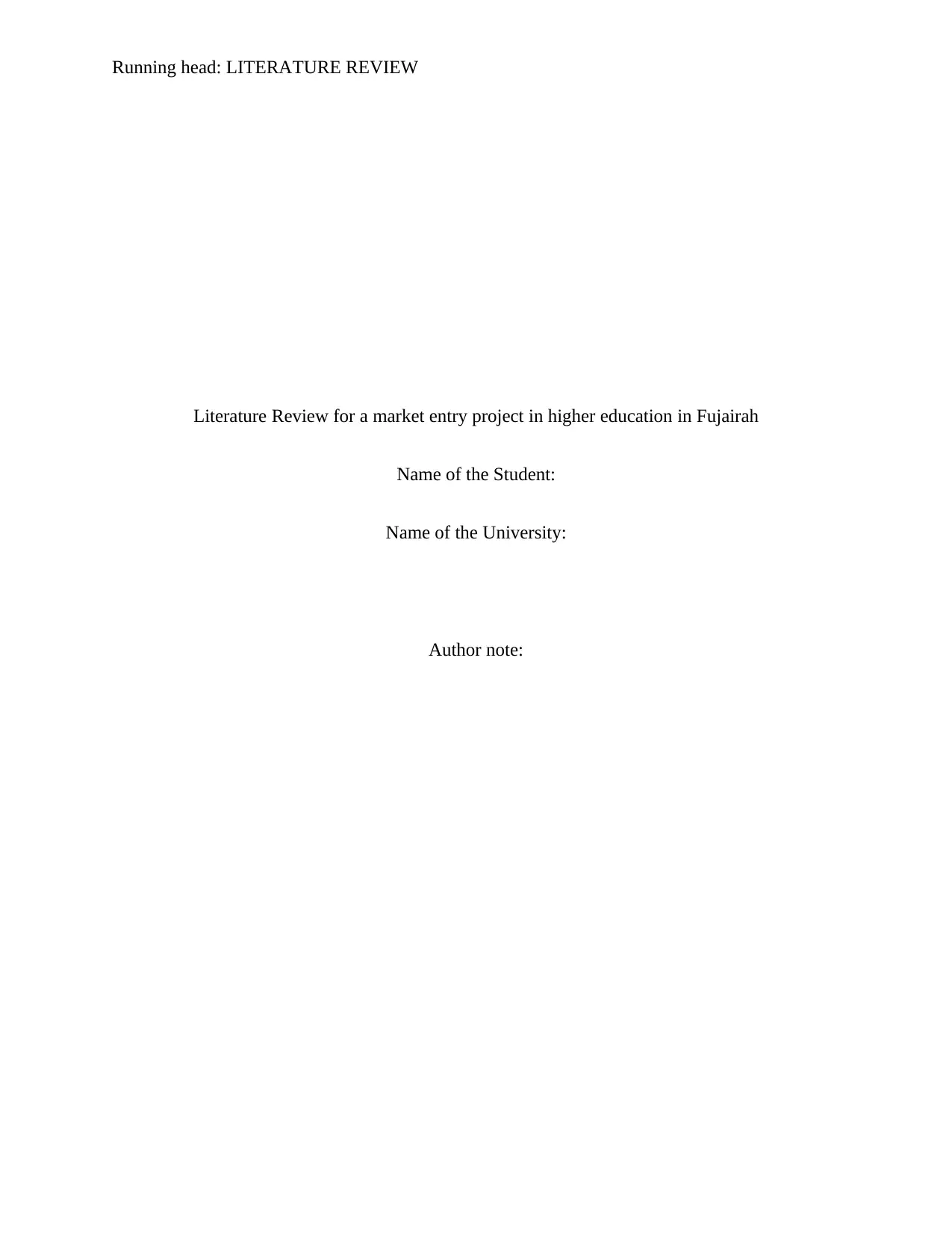
Running head: LITERATURE REVIEW
Literature Review for a market entry project in higher education in Fujairah
Name of the Student:
Name of the University:
Author note:
Literature Review for a market entry project in higher education in Fujairah
Name of the Student:
Name of the University:
Author note:
Paraphrase This Document
Need a fresh take? Get an instant paraphrase of this document with our AI Paraphraser
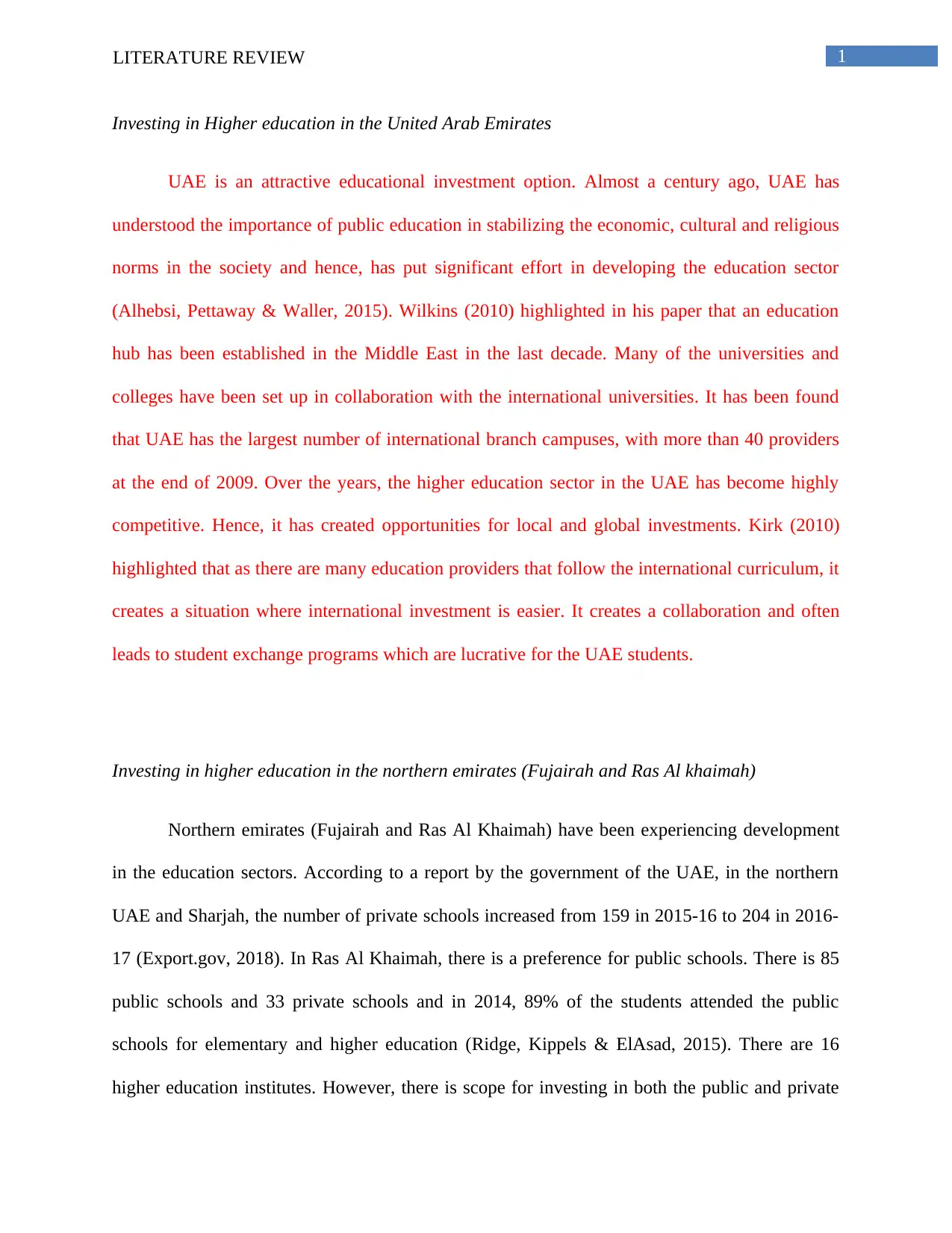
1LITERATURE REVIEW
Investing in Higher education in the United Arab Emirates
UAE is an attractive educational investment option. Almost a century ago, UAE has
understood the importance of public education in stabilizing the economic, cultural and religious
norms in the society and hence, has put significant effort in developing the education sector
(Alhebsi, Pettaway & Waller, 2015). Wilkins (2010) highlighted in his paper that an education
hub has been established in the Middle East in the last decade. Many of the universities and
colleges have been set up in collaboration with the international universities. It has been found
that UAE has the largest number of international branch campuses, with more than 40 providers
at the end of 2009. Over the years, the higher education sector in the UAE has become highly
competitive. Hence, it has created opportunities for local and global investments. Kirk (2010)
highlighted that as there are many education providers that follow the international curriculum, it
creates a situation where international investment is easier. It creates a collaboration and often
leads to student exchange programs which are lucrative for the UAE students.
Investing in higher education in the northern emirates (Fujairah and Ras Al khaimah)
Northern emirates (Fujairah and Ras Al Khaimah) have been experiencing development
in the education sectors. According to a report by the government of the UAE, in the northern
UAE and Sharjah, the number of private schools increased from 159 in 2015-16 to 204 in 2016-
17 (Export.gov, 2018). In Ras Al Khaimah, there is a preference for public schools. There is 85
public schools and 33 private schools and in 2014, 89% of the students attended the public
schools for elementary and higher education (Ridge, Kippels & ElAsad, 2015). There are 16
higher education institutes. However, there is scope for investing in both the public and private
Investing in Higher education in the United Arab Emirates
UAE is an attractive educational investment option. Almost a century ago, UAE has
understood the importance of public education in stabilizing the economic, cultural and religious
norms in the society and hence, has put significant effort in developing the education sector
(Alhebsi, Pettaway & Waller, 2015). Wilkins (2010) highlighted in his paper that an education
hub has been established in the Middle East in the last decade. Many of the universities and
colleges have been set up in collaboration with the international universities. It has been found
that UAE has the largest number of international branch campuses, with more than 40 providers
at the end of 2009. Over the years, the higher education sector in the UAE has become highly
competitive. Hence, it has created opportunities for local and global investments. Kirk (2010)
highlighted that as there are many education providers that follow the international curriculum, it
creates a situation where international investment is easier. It creates a collaboration and often
leads to student exchange programs which are lucrative for the UAE students.
Investing in higher education in the northern emirates (Fujairah and Ras Al khaimah)
Northern emirates (Fujairah and Ras Al Khaimah) have been experiencing development
in the education sectors. According to a report by the government of the UAE, in the northern
UAE and Sharjah, the number of private schools increased from 159 in 2015-16 to 204 in 2016-
17 (Export.gov, 2018). In Ras Al Khaimah, there is a preference for public schools. There is 85
public schools and 33 private schools and in 2014, 89% of the students attended the public
schools for elementary and higher education (Ridge, Kippels & ElAsad, 2015). There are 16
higher education institutes. However, there is scope for investing in both the public and private
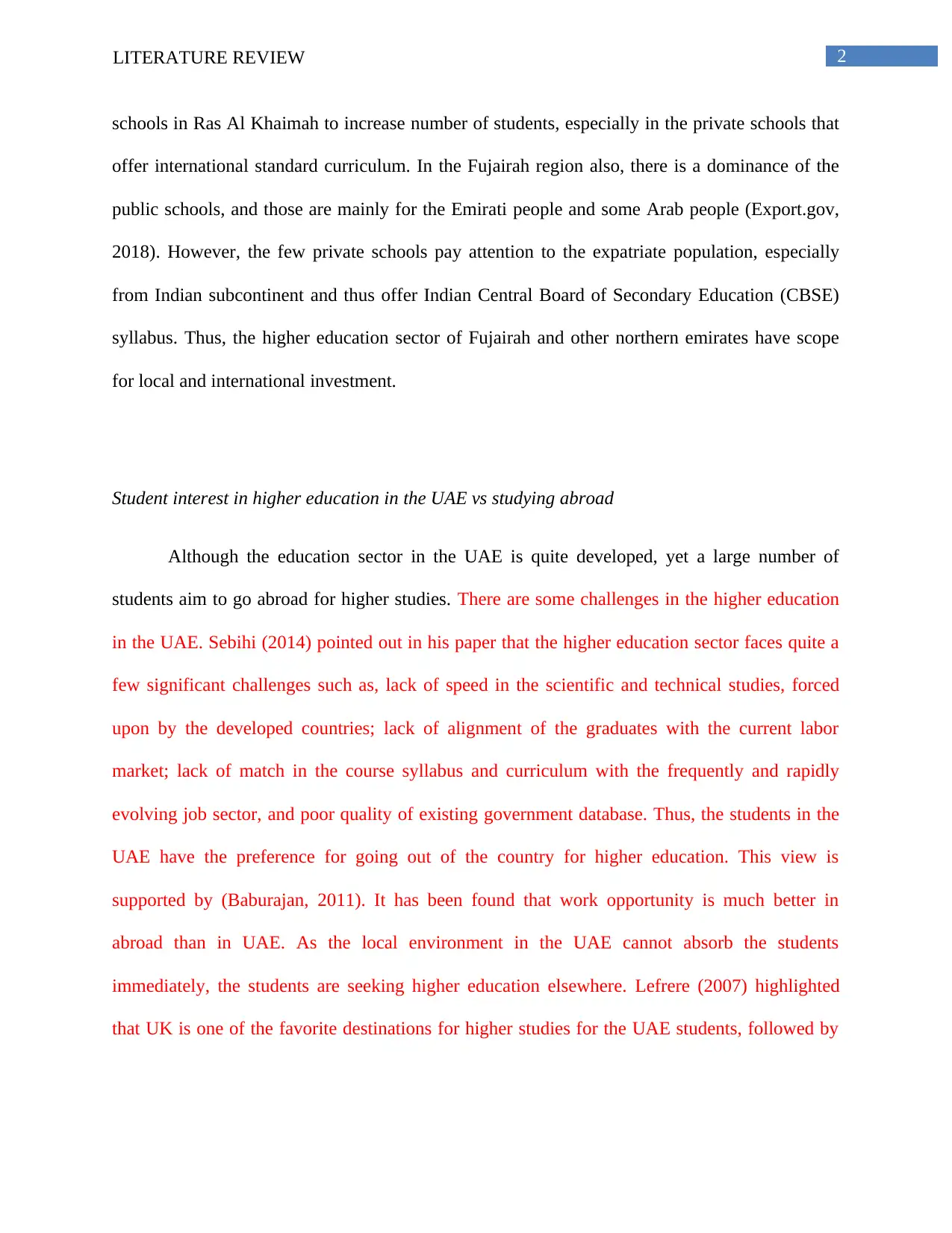
2LITERATURE REVIEW
schools in Ras Al Khaimah to increase number of students, especially in the private schools that
offer international standard curriculum. In the Fujairah region also, there is a dominance of the
public schools, and those are mainly for the Emirati people and some Arab people (Export.gov,
2018). However, the few private schools pay attention to the expatriate population, especially
from Indian subcontinent and thus offer Indian Central Board of Secondary Education (CBSE)
syllabus. Thus, the higher education sector of Fujairah and other northern emirates have scope
for local and international investment.
Student interest in higher education in the UAE vs studying abroad
Although the education sector in the UAE is quite developed, yet a large number of
students aim to go abroad for higher studies. There are some challenges in the higher education
in the UAE. Sebihi (2014) pointed out in his paper that the higher education sector faces quite a
few significant challenges such as, lack of speed in the scientific and technical studies, forced
upon by the developed countries; lack of alignment of the graduates with the current labor
market; lack of match in the course syllabus and curriculum with the frequently and rapidly
evolving job sector, and poor quality of existing government database. Thus, the students in the
UAE have the preference for going out of the country for higher education. This view is
supported by (Baburajan, 2011). It has been found that work opportunity is much better in
abroad than in UAE. As the local environment in the UAE cannot absorb the students
immediately, the students are seeking higher education elsewhere. Lefrere (2007) highlighted
that UK is one of the favorite destinations for higher studies for the UAE students, followed by
schools in Ras Al Khaimah to increase number of students, especially in the private schools that
offer international standard curriculum. In the Fujairah region also, there is a dominance of the
public schools, and those are mainly for the Emirati people and some Arab people (Export.gov,
2018). However, the few private schools pay attention to the expatriate population, especially
from Indian subcontinent and thus offer Indian Central Board of Secondary Education (CBSE)
syllabus. Thus, the higher education sector of Fujairah and other northern emirates have scope
for local and international investment.
Student interest in higher education in the UAE vs studying abroad
Although the education sector in the UAE is quite developed, yet a large number of
students aim to go abroad for higher studies. There are some challenges in the higher education
in the UAE. Sebihi (2014) pointed out in his paper that the higher education sector faces quite a
few significant challenges such as, lack of speed in the scientific and technical studies, forced
upon by the developed countries; lack of alignment of the graduates with the current labor
market; lack of match in the course syllabus and curriculum with the frequently and rapidly
evolving job sector, and poor quality of existing government database. Thus, the students in the
UAE have the preference for going out of the country for higher education. This view is
supported by (Baburajan, 2011). It has been found that work opportunity is much better in
abroad than in UAE. As the local environment in the UAE cannot absorb the students
immediately, the students are seeking higher education elsewhere. Lefrere (2007) highlighted
that UK is one of the favorite destinations for higher studies for the UAE students, followed by
⊘ This is a preview!⊘
Do you want full access?
Subscribe today to unlock all pages.

Trusted by 1+ million students worldwide
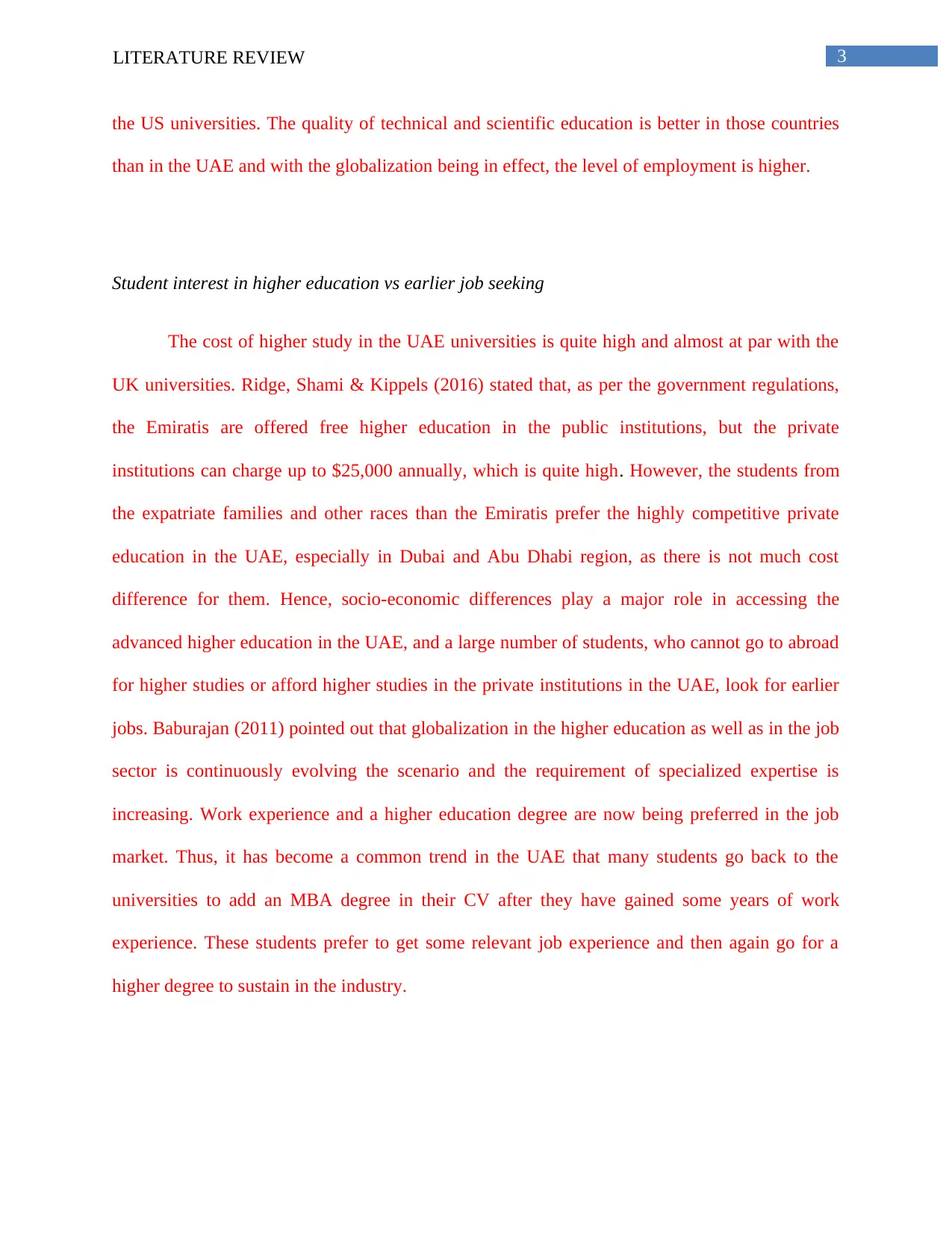
3LITERATURE REVIEW
the US universities. The quality of technical and scientific education is better in those countries
than in the UAE and with the globalization being in effect, the level of employment is higher.
Student interest in higher education vs earlier job seeking
The cost of higher study in the UAE universities is quite high and almost at par with the
UK universities. Ridge, Shami & Kippels (2016) stated that, as per the government regulations,
the Emiratis are offered free higher education in the public institutions, but the private
institutions can charge up to $25,000 annually, which is quite high. However, the students from
the expatriate families and other races than the Emiratis prefer the highly competitive private
education in the UAE, especially in Dubai and Abu Dhabi region, as there is not much cost
difference for them. Hence, socio-economic differences play a major role in accessing the
advanced higher education in the UAE, and a large number of students, who cannot go to abroad
for higher studies or afford higher studies in the private institutions in the UAE, look for earlier
jobs. Baburajan (2011) pointed out that globalization in the higher education as well as in the job
sector is continuously evolving the scenario and the requirement of specialized expertise is
increasing. Work experience and a higher education degree are now being preferred in the job
market. Thus, it has become a common trend in the UAE that many students go back to the
universities to add an MBA degree in their CV after they have gained some years of work
experience. These students prefer to get some relevant job experience and then again go for a
higher degree to sustain in the industry.
the US universities. The quality of technical and scientific education is better in those countries
than in the UAE and with the globalization being in effect, the level of employment is higher.
Student interest in higher education vs earlier job seeking
The cost of higher study in the UAE universities is quite high and almost at par with the
UK universities. Ridge, Shami & Kippels (2016) stated that, as per the government regulations,
the Emiratis are offered free higher education in the public institutions, but the private
institutions can charge up to $25,000 annually, which is quite high. However, the students from
the expatriate families and other races than the Emiratis prefer the highly competitive private
education in the UAE, especially in Dubai and Abu Dhabi region, as there is not much cost
difference for them. Hence, socio-economic differences play a major role in accessing the
advanced higher education in the UAE, and a large number of students, who cannot go to abroad
for higher studies or afford higher studies in the private institutions in the UAE, look for earlier
jobs. Baburajan (2011) pointed out that globalization in the higher education as well as in the job
sector is continuously evolving the scenario and the requirement of specialized expertise is
increasing. Work experience and a higher education degree are now being preferred in the job
market. Thus, it has become a common trend in the UAE that many students go back to the
universities to add an MBA degree in their CV after they have gained some years of work
experience. These students prefer to get some relevant job experience and then again go for a
higher degree to sustain in the industry.
Paraphrase This Document
Need a fresh take? Get an instant paraphrase of this document with our AI Paraphraser
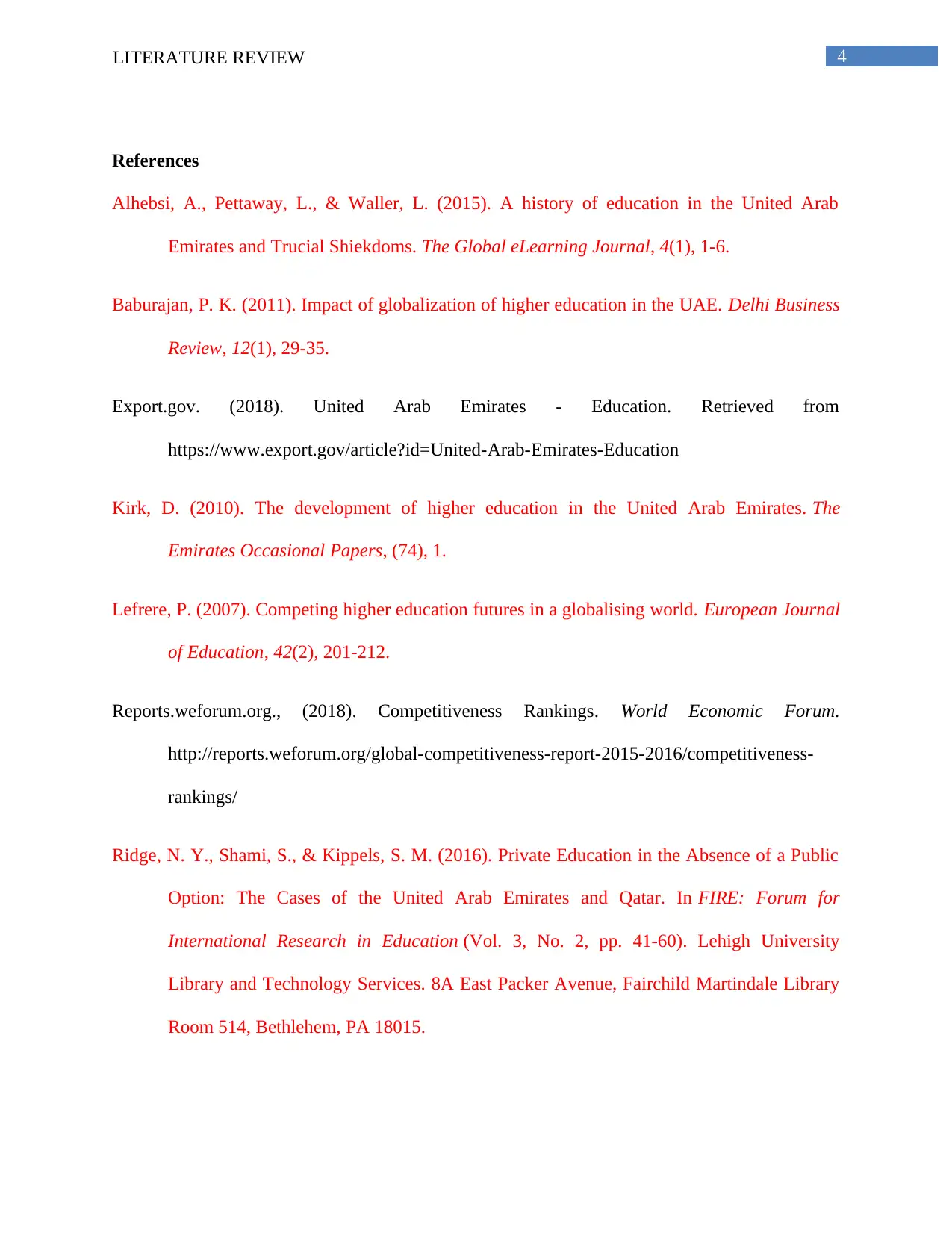
4LITERATURE REVIEW
References
Alhebsi, A., Pettaway, L., & Waller, L. (2015). A history of education in the United Arab
Emirates and Trucial Shiekdoms. The Global eLearning Journal, 4(1), 1-6.
Baburajan, P. K. (2011). Impact of globalization of higher education in the UAE. Delhi Business
Review, 12(1), 29-35.
Export.gov. (2018). United Arab Emirates - Education. Retrieved from
https://www.export.gov/article?id=United-Arab-Emirates-Education
Kirk, D. (2010). The development of higher education in the United Arab Emirates. The
Emirates Occasional Papers, (74), 1.
Lefrere, P. (2007). Competing higher education futures in a globalising world. European Journal
of Education, 42(2), 201-212.
Reports.weforum.org., (2018). Competitiveness Rankings. World Economic Forum.
http://reports.weforum.org/global-competitiveness-report-2015-2016/competitiveness-
rankings/
Ridge, N. Y., Shami, S., & Kippels, S. M. (2016). Private Education in the Absence of a Public
Option: The Cases of the United Arab Emirates and Qatar. In FIRE: Forum for
International Research in Education (Vol. 3, No. 2, pp. 41-60). Lehigh University
Library and Technology Services. 8A East Packer Avenue, Fairchild Martindale Library
Room 514, Bethlehem, PA 18015.
References
Alhebsi, A., Pettaway, L., & Waller, L. (2015). A history of education in the United Arab
Emirates and Trucial Shiekdoms. The Global eLearning Journal, 4(1), 1-6.
Baburajan, P. K. (2011). Impact of globalization of higher education in the UAE. Delhi Business
Review, 12(1), 29-35.
Export.gov. (2018). United Arab Emirates - Education. Retrieved from
https://www.export.gov/article?id=United-Arab-Emirates-Education
Kirk, D. (2010). The development of higher education in the United Arab Emirates. The
Emirates Occasional Papers, (74), 1.
Lefrere, P. (2007). Competing higher education futures in a globalising world. European Journal
of Education, 42(2), 201-212.
Reports.weforum.org., (2018). Competitiveness Rankings. World Economic Forum.
http://reports.weforum.org/global-competitiveness-report-2015-2016/competitiveness-
rankings/
Ridge, N. Y., Shami, S., & Kippels, S. M. (2016). Private Education in the Absence of a Public
Option: The Cases of the United Arab Emirates and Qatar. In FIRE: Forum for
International Research in Education (Vol. 3, No. 2, pp. 41-60). Lehigh University
Library and Technology Services. 8A East Packer Avenue, Fairchild Martindale Library
Room 514, Bethlehem, PA 18015.
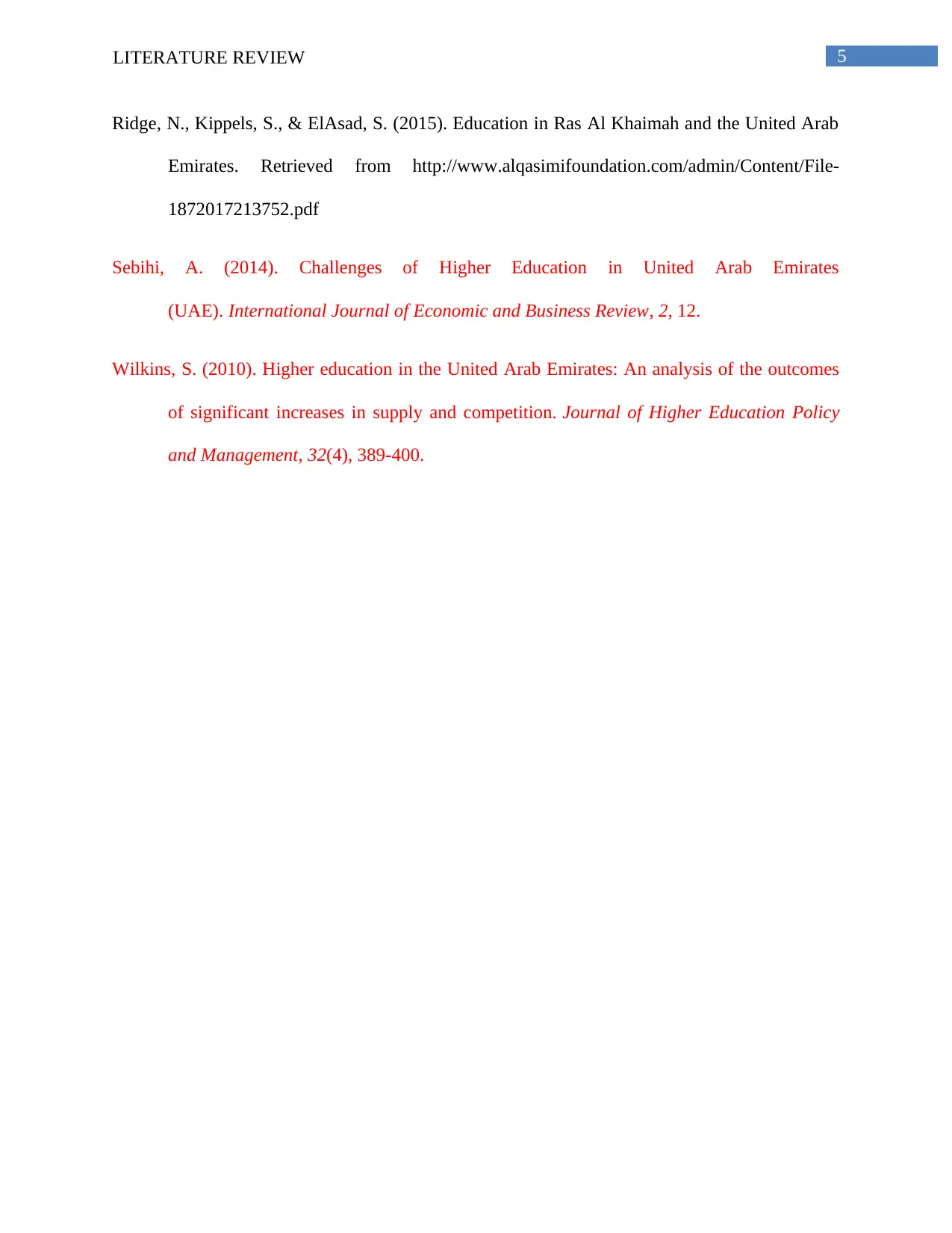
5LITERATURE REVIEW
Ridge, N., Kippels, S., & ElAsad, S. (2015). Education in Ras Al Khaimah and the United Arab
Emirates. Retrieved from http://www.alqasimifoundation.com/admin/Content/File-
1872017213752.pdf
Sebihi, A. (2014). Challenges of Higher Education in United Arab Emirates
(UAE). International Journal of Economic and Business Review, 2, 12.
Wilkins, S. (2010). Higher education in the United Arab Emirates: An analysis of the outcomes
of significant increases in supply and competition. Journal of Higher Education Policy
and Management, 32(4), 389-400.
Ridge, N., Kippels, S., & ElAsad, S. (2015). Education in Ras Al Khaimah and the United Arab
Emirates. Retrieved from http://www.alqasimifoundation.com/admin/Content/File-
1872017213752.pdf
Sebihi, A. (2014). Challenges of Higher Education in United Arab Emirates
(UAE). International Journal of Economic and Business Review, 2, 12.
Wilkins, S. (2010). Higher education in the United Arab Emirates: An analysis of the outcomes
of significant increases in supply and competition. Journal of Higher Education Policy
and Management, 32(4), 389-400.
⊘ This is a preview!⊘
Do you want full access?
Subscribe today to unlock all pages.

Trusted by 1+ million students worldwide
1 out of 6
Related Documents
Your All-in-One AI-Powered Toolkit for Academic Success.
+13062052269
info@desklib.com
Available 24*7 on WhatsApp / Email
![[object Object]](/_next/static/media/star-bottom.7253800d.svg)
Unlock your academic potential
Copyright © 2020–2025 A2Z Services. All Rights Reserved. Developed and managed by ZUCOL.





